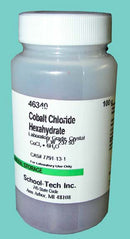Description
Cobalt chloride crystals are commonly used in classrooms for chemistry experiments and demonstrations, primarily to study chemical properties and investigate reactions involving moisture and hydration. The most notable uses include:
-
Indicator for Humidity and Hydration: Cobalt chloride is a popular indicator for moisture because it changes color based on its hydration state. In its anhydrous form, cobalt chloride is blue, and it turns pink when it absorbs water. This property makes it ideal for demonstrating reversible chemical changes and teaching about hydration and dehydration reactions.
-
Le Chatelier’s Principle Demonstrations: Cobalt chloride can be used to illustrate Le Chatelier's Principle. By adding water or applying heat to the crystal, students can observe the reversible color change, demonstrating shifts in equilibrium due to changes in temperature or the presence of a reactant.
-
Testing for Water Presence: Cobalt chloride paper, which is made using the crystals, is used in chemistry and environmental science labs to detect water vapor in various gases or liquids.
Due to its potential toxicity and the fact that it can cause skin irritation, cobalt chloride should be handled with proper safety measures, including wearing gloves and protective eyewear.

